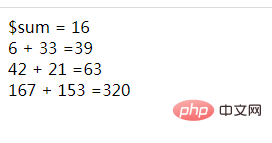Do you not need to fill in the parameters of the php function?
There is no need to fill in the parameters of the php function. In PHP functions, function parameters can be omitted. If the function omits parameters, the tasks performed by the function are fixed. The user cannot change some execution behaviors inside the function when calling the function; if the function does not omit parameters, the function can be changed from The data values required for function execution are obtained externally, and how to execute the function body internally can be determined based on the data passed by the user.

The operating environment of this tutorial: windows7 system, PHP8.1 version, DELL G3 computer
During development, some commonly used functions can be used Call system functions to complete. But if some functions do not provide system functions in PHP, we need to define the functions ourselves. To complete the same task, the execution efficiency of using system functions will be higher than that of custom functions, but there is no difference in how the two functions are called in the program.
To declare a custom function in PHP, you can use the following syntax format:
function 函数名 (参数1, 参数2, ..., 参数n){
函数体;
return 返回值;
}The first line of each function is the function header, which consists of the keywords function and function when declaring the function. It consists of three parts: name and parameter list, each part performs a specific function.
The parameter list of a function consists of zero or more parameters, separated by commas. Parameters are the ports for data exchange inside and outside the function. The input of data in the function is completed by parameters.
If the function does not have a parameter list, the task performed by the function is fixed, and the user cannot change some execution behaviors inside the function when calling the function.
function 函数名(){
函数体;
return 返回值;
}If the function has a parameter list, the function can obtain the data values required for function execution from the outside. That is, when the user calls a function, before the function body is executed, some data is passed into the function through the parameter list of the function. In this way, when the function executes the function body, it can determine what is going on inside the function body based on the data passed by the user. implement.
Example 1: If the parameter is omitted, the fixed function will be executed--print the multiplication table
<?php
function table(){ //定义函数
for ($i = 1; $i <= 9; $i++) {
for ($j = 1; $j <= $i; $j++) {
echo $j.' * '.$i.' = '.$i*$j.' ';
}
echo '<br>';
}
}
table();//调用函数
?>
Example 2: No Omit parameters, the data is changeable - implement simple addition operations
<?php
function add($num1,$num2){
$a = $num1 + $num2;
return $a;
}
$sum = add(11,5);
echo '$sum = '.$sum.'<br>';
echo '6 + 33 ='.add(6,33).'<br>';
echo '42 + 21 ='.add(42,21).'<br>';
echo '167 + 153 ='.add(167,153);
?>
Recommended learning: "PHP Video Tutorial"
The above is the detailed content of Do you not need to fill in the parameters of the php function?. For more information, please follow other related articles on the PHP Chinese website!

Hot AI Tools

Undresser.AI Undress
AI-powered app for creating realistic nude photos

AI Clothes Remover
Online AI tool for removing clothes from photos.

Undress AI Tool
Undress images for free

Clothoff.io
AI clothes remover

AI Hentai Generator
Generate AI Hentai for free.

Hot Article

Hot Tools

Notepad++7.3.1
Easy-to-use and free code editor

SublimeText3 Chinese version
Chinese version, very easy to use

Zend Studio 13.0.1
Powerful PHP integrated development environment

Dreamweaver CS6
Visual web development tools

SublimeText3 Mac version
God-level code editing software (SublimeText3)

Hot Topics
 1371
1371
 52
52
 CakePHP Project Configuration
Sep 10, 2024 pm 05:25 PM
CakePHP Project Configuration
Sep 10, 2024 pm 05:25 PM
In this chapter, we will understand the Environment Variables, General Configuration, Database Configuration and Email Configuration in CakePHP.
 PHP 8.4 Installation and Upgrade guide for Ubuntu and Debian
Dec 24, 2024 pm 04:42 PM
PHP 8.4 Installation and Upgrade guide for Ubuntu and Debian
Dec 24, 2024 pm 04:42 PM
PHP 8.4 brings several new features, security improvements, and performance improvements with healthy amounts of feature deprecations and removals. This guide explains how to install PHP 8.4 or upgrade to PHP 8.4 on Ubuntu, Debian, or their derivati
 CakePHP Date and Time
Sep 10, 2024 pm 05:27 PM
CakePHP Date and Time
Sep 10, 2024 pm 05:27 PM
To work with date and time in cakephp4, we are going to make use of the available FrozenTime class.
 CakePHP Working with Database
Sep 10, 2024 pm 05:25 PM
CakePHP Working with Database
Sep 10, 2024 pm 05:25 PM
Working with database in CakePHP is very easy. We will understand the CRUD (Create, Read, Update, Delete) operations in this chapter.
 CakePHP File upload
Sep 10, 2024 pm 05:27 PM
CakePHP File upload
Sep 10, 2024 pm 05:27 PM
To work on file upload we are going to use the form helper. Here, is an example for file upload.
 CakePHP Routing
Sep 10, 2024 pm 05:25 PM
CakePHP Routing
Sep 10, 2024 pm 05:25 PM
In this chapter, we are going to learn the following topics related to routing ?
 Discuss CakePHP
Sep 10, 2024 pm 05:28 PM
Discuss CakePHP
Sep 10, 2024 pm 05:28 PM
CakePHP is an open-source framework for PHP. It is intended to make developing, deploying and maintaining applications much easier. CakePHP is based on a MVC-like architecture that is both powerful and easy to grasp. Models, Views, and Controllers gu
 CakePHP Creating Validators
Sep 10, 2024 pm 05:26 PM
CakePHP Creating Validators
Sep 10, 2024 pm 05:26 PM
Validator can be created by adding the following two lines in the controller.




